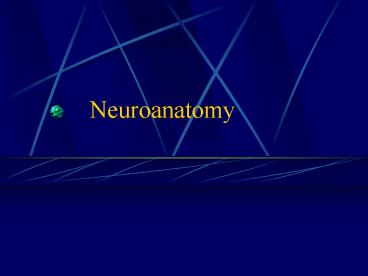Neuroanatomy - PowerPoint PPT Presentation
1 / 11
Title:
Neuroanatomy
Description:
The striatum (afferent, or receptive portion of the basal ganglia control ... important in this basal ganglia loop in both afferent and efferent directions. ... – PowerPoint PPT presentation
Number of Views:162
Avg rating:3.0/5.0
Title: Neuroanatomy
1
Neuroanatomy
2
- D. Deep Structures
- 1. Basal Ganglia
- a) Striatum Caudate Nucleus Putamen
The basal ganglia control circuit will become
very important to us later in the course, so its
important to understand where theyre located.
First, lets examine the striatum. The striatum
(afferent, or receptive portion of the basal
ganglia control circuit) receive input from
frontal cortex and from the thalamus and the
substantia nigra. The striatum then send
efferent fibers to the substantia nigra and to
the globus pallidus.
3
Caudate Nucleus
Putamen
4
- D. Deep Structures
- 1. Basal Ganglia
- a) Striatum Caudate Nucleus Putamen
- b) Lenticular Nucleus Putamen Globus Pallidus
Next, lets look at the efferent (or expressive)
portion of the basal ganglia control circuit. The
major efferent pathways of the basal ganglia are
in the globus pallidus. These send fibers to
thalamus, which sends them back to the motor
cortex, and to the subthalamic nucleus, the red
nucleus, and the reticular formation (see
following slide)
5
Putamen
Lateral Ventricles
Globus Pallidus
6
- D. Deep Structures
- 1. Basal Ganglia
- a) Striatum Caudate Nucleus Putamen
- b) Lenticular Nucleus Putamen Globus
Pallidus - 2. Thalamus
The thalamus becomes important in this basal
ganglia loop in both afferent and efferent
directions. The striatum (receptive portion),
recall, receive input from the thalamus (among
other regions) The globus pallidus (part of the
efferent circuit) sends fibers to thalamus (see
thalamus, next slide).
7
Thalamus
Lateral Ventricles
8
- D. Deep Structures
- 1. Basal Ganglia
- a) Striatum Caudate Nucleus Putamen
- b) Lenticular Nucleus Putamen Globus
Pallidus - 2. Thalamus
- 3. Hypothalamus
The hypothalamus, shown on the next two slides,
is a nucleus of gray matter that connects to some
of the autonomic centers, and regulates
reproductive behavior, desire for food and water,
digestion, and body temperature.
9
Hypo- thalamus
10
Thalamus
Hypo- Thalamus
11
- D. Deep Structures
- 1. Basal Ganglia
- a) Striatum Caudate Nucleus Putamen
- b) Lenticular Nucleus Putamen Globus
Pallidus - 2. Thalamus
- 3. Hypothalamus
- 4. Internal Capsule
The internal capsule (in the Part 5 slides)
comprises white matter, unlike the previously
discussed deep structures. The axons for the
direct activation pathway neurons form the corona
radiata (also white matter) and converge in the
internal capsule, leading ultimately to the
speech musculature.














![READ [PDF] Atlas of Neuroanatomy and Special Sense Organs PowerPoint PPT Presentation](https://s3.amazonaws.com/images.powershow.com/10075116.th0.jpg?_=20240709094)
![[PDF] Neuroanatomy : An Illustrated Colour Text Free PowerPoint PPT Presentation](https://s3.amazonaws.com/images.powershow.com/10082458.th0.jpg?_=20240720116)




![[PDF] Neuroanatomy Text and Atlas Ipad PowerPoint PPT Presentation](https://s3.amazonaws.com/images.powershow.com/10082462.th0.jpg?_=20240720118)




![[PDF] Neuroanatomy Coloring Book: Human Brain Coloring Book for Neuroscience and Neuroanatomy Workbook Free PowerPoint PPT Presentation](https://s3.amazonaws.com/images.powershow.com/10082460.th0.jpg?_=20240720117)





